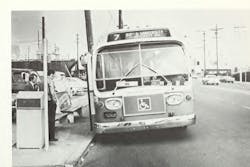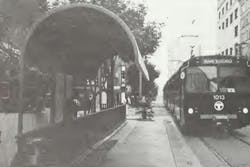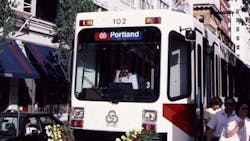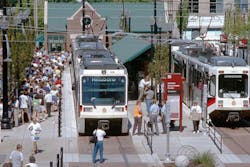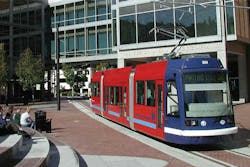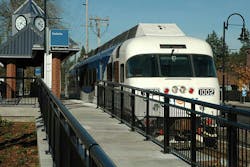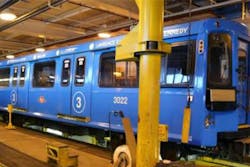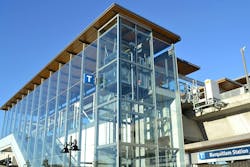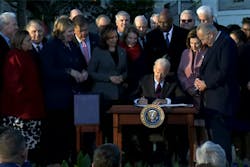
In June 1974, Mass Transit Magazine was founded by Charles Carroll Carter, who would pass away at age 92 on May 14, 2021.
As Carter made clear in his inaugural editorial, Mass Transit was created with one mission: To break new ground as the first international trade magazine with comprehensive editorial coverage of “all forms of public transit in cities” and to provide a much-needed “forum for effective communication between people in every phase of the transportation industry–including local, state and federal government officials, planners and developers, manufacturers and users–the transit riding public.”
To celebrate the 50th anniversary of Mass Transit, the Mass Transit editorial team has put together a list of the top moments in the industry during the past five decades.
1974- The Urban Mass Transportation Administration (UMTA) Act was amended to provide federal funding for urban public transportation, helping develop and expand mass transit.
1974- The last surviving street railway systems in the U.S. (Boston, Mass., Cleveland, Ohio, Newark, N.J., New Orleans, La., Philadelphia and Pittsburgh, Pa., and San Francisco, Calif.).
1974- The remaining two stations of the north Yonge Subway extension, Sheppard Station and Finch Station, open in March in Toronto, Ontario.
1975- The first automated guideway transit agency is established at West Virginia University in Morgantown, W.Va.
1976- The first portion in the Washington Metrorail system opens for service in Washington, D.C.
1977- The Clean Air Act Amendments of 1977 set new emission standards for vehicles and provided monetary incentives for transit agencies to adopt lower-emission vehicles.
1977- The first wheelchair-lift-equipped fixed-route bus begins service in San Diego, Calif.
1978- The Spadina Subway line opens in January in Toronto, Ontario
1980- The San Diego, Calif., Trolley is completed.
1983- The Surface Transportation Assistance Act, which established formulas to apportion funds for transit agencies, was signed into law on Jan. 6.
1985- The Expo SkyTrain Line opens Dec. 11 in Vancouver, B.C.
1986- TriMet opens the Banfield Light Rail in Portland, Ore.
1989- The first new commuter rail transit agency in decades, the Tri-County Commuter Rail Authority in Miami, Fla., is built.
1990- The first National Transit Summaries and Trends report, which provided an overview of the national public transit industry and highlighted financial, operational and time series data trends, was released.
1990- The Toronto Transit Commission (TTC) opens the Harbourfront Light Rail Transit line in Toronto, Ontario.
1991- The Intermodal Surface Transportation Efficiency Act, which encouraged a multi-modal use of transportation, promoted safety and environmental protections and gave local communities more control over how to use federal funds, was signed into law on Dec. 18.
1991- The Federal Transit Act Amendments of 1991, from the Intermodal Transportation Efficiency Act, changed the name of UMTA to the Federal Transit Administration (FTA).
1991- The Clean Air Act Amendments of 1990 established strict pollution controls for transportation buses.
1992- The National Transit Institute was established under the Intermodal Surface Transportation Efficiency Act to develop and provide training programs to the nation’s public transit industry.
1998- The Transportation Equity Act for the 21st century was signed into law on June 9, expanding funds for transportation projects and restructuring federal public transportation programs, with a focus on improving equity and accessibility.
1998- An 18-mile light-rail extension opened from downtown Portland, Ore., through the western suburb of Beaverton to Hillsboro, serving the fast-growing high-tech corridor in Washington County.
2002- Monthly ridership and safety and security reporting requirements are initiated under the redesigned National Transit Database (NTD).
2002- The Millennium SkyTrain Line opens in Vancouver, B.C., joining the Expo Line.
2005- The opening of the 1.2-mile RiverPlace extension lengthened the Portland Streetcar line to six miles total, with 40 platform stops.
2009- More than 10 years in the making, TriMet’s 14.7-mile Westside Express Service Commuter Rail line opens on Feb 2.
2012- The Moving Ahead for Progress in the 21st Century (MAP-21) Act was signed into law, providing funding stability, promoting performance-based planning, emphasizing maintenance of transit infrastructure and encouraging innovating and safety improvements for public transit agencies.
2014- The Scarborough RT line was renamed the Line 3 Scarborough as part of the new line numbering for all four TTC rapid transit lines.
2015- FTA updates the Safety & Security Module in the NTD Reporting Manual to better align NTD safety data collection with data collected in the State Safety Oversight program Rail Transit Event Database.
2015- The Fixing America’s Surface Transportation (FAST) Act was signed into law, providing long-term funding stability, enhancing safety measures, supporting innovation and streamlining regulatory processes for public transit agencies.
2015- TriMet opens the Portland-Milwaukie light-rail transit line on Sept. 12.
2016- FTA issued a final rule requiring transit agencies develop a Transit Asset Management (TAM) plan. The TAM plan is submitted alongside asset inventory module data to the NTD and it is used by agencies to monitor and manage their capital assets, achieve and maintain a state of good repair, increase system reliability and performance, reduce operation delays, promote resilience, reduce costs and yield system improvements.
2016- FTA establishes the Low or No Emission Grant Program, as authorized by the FAST Act, with $55 million in funding for agencies to purchase low- or no-emission buses and related infrastructure, helping reduce greenhouse gas emissions and air pollution.
2016- The Evergreen Extension of the Millennium SkyTrain Line opens, adding six stations and connecting the cities of Coquitlam and Port Moody, B.C., to the network.
2017- FTA updated its guidance on reportable safety events to collect data for safety events that occur on transit infrastructure.
2020- The Coronavirus Aid, Relief, and Economic Security Act was enacted on March 23, providing emergency funding to support public transit agencies during the COVID-19 pandemic, helping to maintain essential transit services, protect jobs and ensure the safety of passengers and workers.
2021- The Infrastructure Investment and Jobs (IIJA) was signed into law on Nov. 15. It allocated significant funding to improve public transit infrastructure and services in the U.S., addressing State of Good Repair backlogs, expanding accessibility, enhancing sustainability and promoting innovation to modernize transit systems nationwide.
2022- As a result of the IIJA, FTA began collecting additional data from reporters, including their geographic service area coverage through the General Transit Feed Specification, as well as the number of assaults on transit workers.
About the Author
Mass Transit Staff Report
Stories under this byline were produced through a team effort by the editorial staff of Mass Transit.
To learn more about our team, click here.
If you have a story idea, let us know by emailing [email protected]. Please review our contributor guidelines found here.


